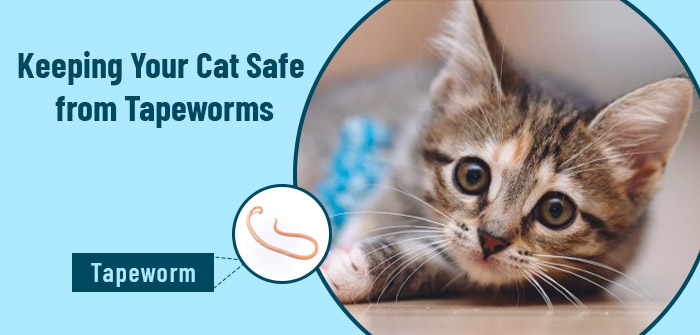Keeping Your Cat Safe from Tapeworms
Tapeworms are one of the most common worms that infect cats. These nasty little pests take a free ride on the fleas and then infect the feline’s intestine. Knowing the infection symptoms, risks, precautions, and safety measures are important for taking care of your cat.

What are Tapeworms?
Dipylidium caninum or tapeworm is a long, flat, and white segmented worm that gets attached to the intestine using its hook-like mouth. The adult worms can grow up to 70cm in length. Proglottids are segments of adult worms that break off and are passed through stool. You can observe white-rice-like segments in the feces or stuck on the fur under the tail. One proglottid can contain up to 20 tapeworm eggs.
How can your cat get the tapeworm?
Ingesting fleas is the only way for your pet to get the tapeworm. The tapeworm eggs hatch and become larvae inside a flea; when this infected flea is consumed by the cat, it is digested, and the larvae are released and get attached to the intestine. Your cat can swallow the flea during grooming or by eating a flea-infested rodent. Infections are prevalent in the areas that have more fleas.
No fleas, no tapeworm.
How do you know that your cat is infected?
If you see some moving rice-like segments near the rear end of your feline friend or see them trying to itch at the place more often, which is the first indicator of infection. Certain symptoms can be-
- Vomiting.
- Diarrhea
- Weight loss
- Lethargy
If you observe any of these symptoms, immediately take them to a veterinarian. They will be prescribed certain treatments.
How to treat and prevent Tapeworms?
Luckily, there are treatments available for tapeworm infection. You can consult your veterinarian before administrating any medicine. The treatment contains medication for killing tapeworm and fleas –destroying the root cause- this will help in preventing further infection as well.
You can find many dewormers on VetSupply that target all the lifecycle stages of the worms. The most effective method to prevent tapeworm is to control fleas; anti-fleas and ticks medicine can be used at regular intervals to prevent flea infestation.
Remember
Even indoor cats can be susceptible to fleas. Following a strict hygiene routine for your house, children, and pets will keep the infection rate low. Give your cat a regular check-up. Clean up thoroughly after playing outside to prevent bringing fleas from parks. These small precautions can keep your cat safe from tapeworms.

